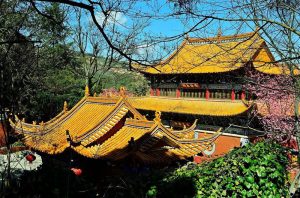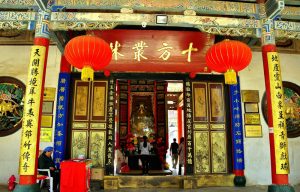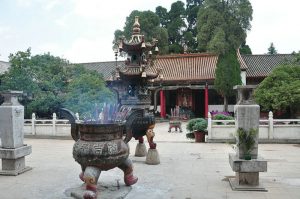 alt="Market Days in Xuanwei City and Townships, Qujing"
/>
alt="Market Days in Xuanwei City and Townships, Qujing"
/>
Bamboo Temple, Kunming

Chinese Name: 筇竹寺
English Name: Bamboo Temple
Type:Buddhist Temple, Cultural Landscape
Best Time: All Year Around
Recommended Visiting Time: 40 minutes
Opening Hours: 8:30-17:00
Admission Fee: ¥5
Location: About twelve kilometers away from downtown of Kunming
Why is Bamboo Temple so special?
Bamboo Temple is a famous Buddhist temple in Yunnan. These life-sized clay figures are stunning – either very realistic or very surrealistic. Down one huge wall come the incredible surfing Buddhas, some 70 odd, riding the waves on a variety of mounts – blue dogs, giant crabs shrimp, turtles, unicorns. One gentleman has meter long eyebrows; another has an arm that shoots clear across the hall to the ceiling.
Introduction

Legend of Bamboo Temple
During the Tang Dynasty (618 – 907), Yunnan was a separate country called Dali. One day, while two brothers of royal lineage were hunting in the hills outside Kunming, they spotted a bizarre rhinoceros. With hopes of capturing it, they followed the rhinoceros deep into the woods of Yu’an Mountain where the magical animal suddenly disappeared. Just as they lost sight of the rhinoceros, the brothers saw a group of monks who were unlike any monks they had seen before. When the monks saw the brothers, they vanished in clouds leaving only their walking sticks planted in the ground. By the following day, these walking sticks had become an entire bamboo forest. The amazed brothers knew that they had met enlightened, supernatural beings and, in order to honor them, they built Bamboo Temple in the forest of bamboo.
History of Bamboo Temple
Even though this is a marvelous story, it does not follow the historic record. Account of the Bamboo Temple dates back to the Song Dynasty (960 – 1279), but it was during the Yuan Dynasty (around 1280) that a highly renowned monk, who was reputed to have learned Buddhism from central China, gave his teachings that brought great fame to the temple as a spiritual center. After a devastating fire, the Emperor Guangxu of the Qing Dynasty (1644 – 1911) rebuilt the Bamboo Temple by adding five pavilions during the late 1880’s. Its most outstanding artistic (and perhaps spiritual) feature is the distinguished, finely crafted statues of the 500 Luohans (Buddhist Arhats, or ‘enlightened ones’) sculpted by the brilliant artist, Li Guangxiu.
What to See in Bamboo Temple?
The Great Buddha’s Hall

Huayan Pavilion

Five Hundreds Arhats
What to Do in Bamboo Temple?
1. Admiring Architectural Pattern
2. Exploring Buddhist Culture
Bamboo Temple is the first temple of Chinese Buddhist Zen sect into Yunnan. On October 12, 1994, Bamboo Temple was inaugurated and the Buddha statue opened. The abbot of Bamboo Temple, Mingdao Elder, hold the consecration ceremony.
How to Get to Bamboo Temple
Recommended Bamboo Temple Tours
Top 3 Bamboo Temple chosen by most customers to explore Bamboo Temple in the best way. Check the detailed itinerary, or tailor your own trip now with us. We provide some tour routes for tourists to choose.
1 Day Kunming Temples Tour
13 Days Yunnan Festival Tour in Spring

 7 Days GolfingTour
7 Days GolfingTour
 8 Days Group Tour
8 Days Group Tour
 8 Days Yunnan Tour
8 Days Yunnan Tour
 7 Days Shangri La Hiking
7 Days Shangri La Hiking
 11 Days Yunnan Tour
11 Days Yunnan Tour
 6 Days Yuanyang Terraces
6 Days Yuanyang Terraces
 11 Days Yunnan Tour
11 Days Yunnan Tour
 8 Days South Yunnan
8 Days South Yunnan
 7 Days Tea Tour
7 Days Tea Tour
 8 Days Muslim Tour
8 Days Muslim Tour
 12 Days Self-Driving
12 Days Self-Driving
 4 Days Haba Climbing
4 Days Haba Climbing
 Tiger Leaping Gorge
Tiger Leaping Gorge
 Stone Forest
Stone Forest
 Yunnan-Tibet
Yunnan-Tibet
 Hani Rice Terraces
Hani Rice Terraces
 Kunming
Kunming
 Lijiang
Lijiang
 Shangri-la
Shangri-la
 Dali
Dali
 XishuangBanna
XishuangBanna
 Honghe
Honghe
 Kunming
Kunming
 Lijiang
Lijiang
 Shangri-la
Shangri-la
 Yuanyang Rice Terraces
Yuanyang Rice Terraces
 Nujiang
Nujiang
 XishuangBanna
XishuangBanna
 Spring City Golf
Spring City Golf
 Snow Mountain Golf
Snow Mountain Golf
 Stone Mountain Golf
Stone Mountain Golf













 What Our Customers Say?
What Our Customers Say?
